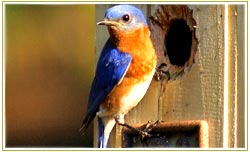 A Bluebird belongs to a group of brightly colored thrushes related to the Robin and native to North America. Bluebirds live in open country that contains scattered trees, usually in old farmlands or orchards. They nest in tree holes or man made boxes which they line with fine grass.
A Bluebird belongs to a group of brightly colored thrushes related to the Robin and native to North America. Bluebirds live in open country that contains scattered trees, usually in old farmlands or orchards. They nest in tree holes or man made boxes which they line with fine grass.
The female Bluebird lays three to seven pale blue or white eggs at a time and may have two or three broods a year. Both parents care for their young that remain in the nest for 15 – 19 days. Bluebirds feed on caterpillars, beetles, grasshoppers and many other insects that may be harmful to crops. When insects are not available in large numbers during winter, Bluebirds eat berries.
Providing water in the form of birdbaths encourages Bluebirds to stick around the backyard. They are quite partial to the sound of dripping water and have no specific preference whether it is a commercial dripper or a self-provided water device. A suitable birdhouse will convince them to stay and nest.
Winter food for Bluebirds can be amply provided for by planting berry-producing shrubs and bushes. American Holly is a particularly good source of winter Bluebird food. Holly berries usually remain on the tree until they soften in late winter. This would be a critical food source at a time when berry sources are depleted.
There are three species of Bluebirds in the United States: Eastern Bluebird, Western Bluebird and the Mountain Bluebird. The Eastern Bluebird measures about 6.5 – 7” in length. A male Eastern Bluebird has a bright blue head, back, wings and tail, rusty red throat, breast and sides with a white belly and under tail coverts. The female Eastern Bluebird’s color is similar to the male, only much duller.
Since Bluebirds are cavity nesters, they are ideal candidates for birdhouse use. In fact, the Bluebirds particularly need human help through their provision of nest boxes. Eastern Bluebirds are usually found in rural gardens, orchards and sub-urban gardens near open farmlands. Winter is definitely on the way out when the eastern Bluebirds start arriving.
 The Mountain Bluebird lives in the mountains of the Western United States and Canada, often sharing territory with the Western Bluebird. They have a strong attraction to burned areas in the first few years after a fire particularly those with many standing trees. Its population increases as logging and grazing activities spread while shows a decline with the spread of fire-suppression practices.
The Mountain Bluebird lives in the mountains of the Western United States and Canada, often sharing territory with the Western Bluebird. They have a strong attraction to burned areas in the first few years after a fire particularly those with many standing trees. Its population increases as logging and grazing activities spread while shows a decline with the spread of fire-suppression practices.
Mountain Bluebirds nest as solitary pairs although nests can be found near each other when available holes are close together. Male Mountain Bluebirds have a turquoise blue head and back, slightly paler breast, deep blue wings and tail and a whitish belly and under tail coverts. Female Mountain Bluebirds look very much like the Western Bluebird and Eastern Bluebird females.
The Western Bluebirds’ suitable habitat occurs in open conifer forests, farms and ranches and in streamside groves. Their habitat requirement is quite similar to that of the Eastern Bluebird thus they exclude each other from their territories where their ranges overlap. Western Bluebirds are generally more tolerant of disturbance.
Male Western Bluebirds have deep blue upper parts and throat with some rusty coloration on the upper back. Female Western Bluebirds are distinguished from their Mountain Bluebird counterparts by the presence of chestnut coloring on the breast and flank. Males often find a mate in a group or a pair which helps at nest.